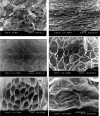Ecofriendly remediation technologies for wastewater contaminated with heavy metals with special focus on using water hyacinth and black tea wastes: a review
- PMID: 34173877
- PMCID: PMC8233605
- DOI: 10.1007/s10661-021-09236-2
Ecofriendly remediation technologies for wastewater contaminated with heavy metals with special focus on using water hyacinth and black tea wastes: a review
Erratum in
-
Correction to: Ecofriendly remediation technologies for wastewater contaminated with heavy metals with special focus on using water hyacinth and black tea wastes: a review.Environ Monit Assess. 2021 Jul 31;193(8):542. doi: 10.1007/s10661-021-09345-y. Environ Monit Assess. 2021. PMID: 34331591 Free PMC article. No abstract available.
Abstract
Treatment of water contaminated with heavy metals is challenging. Heavy metals are non-degradable, persistent in the environment, have a high dispersion capacity by water, can bioaccumulate, and represent risks to human and environmental health. Conventional treatment methods have disadvantages; however, adsorption in biomass is a highly promising method with high efficiency and low cost that avoids many of the disadvantages of conventional methods. Black tea (BT) wastes and water hyacinth (WH) have attracted attention for their ability to remove heavy metals from wastewater. Utilizing these approaches can remove contaminants and effectively manage problematic invasive species and wastes. The conventional uses of BT and WH were efficient for removing heavy metals from wastewater. Due to the unique and distinct properties and advantages of biochar and nano-forms of biosorbents, the use of BT and WH in these forms is promising to achieve sustainable heavy metals removal from wastewater. However, more study is needed to confirm preliminary results.
Keywords: Biochar; Polluted wastewater; Wastes; Wastewater treatment.
Conflict of interest statement
The authors declare no competing interests.
Figures





References
-
- Abdel-Satar AM, Ali MH, Goher ME. Indices of water quality and metal pollution of Nile River. Egypt. The Egyptian Journal of Aquatic Research. 2017;43(1):21–29. doi: 10.1016/j.ejar.2016.12.006. - DOI
-
- Adelodun, B., Ajibade, F. O., Ighalo J. O., Odey, G., Ibrahim, R. G., Kareem, K. Y., Bakare, H. O., Tiamiyu, A. O., Ajibade, T. F., Abdulkadir, T. S., Adeniran, K. A., & Adeniran, K. A. (2020) Assessment of socioeconomic inequality based on virus-contaminated water usage in developing countries: A Review Environmental Research, 110309. 10.1016/j.envres.2020.110309 - PMC - PubMed
-
- Aggarwal, R., & Arora, G. (2020) Biosorption and speciation of chromium in aqueous medium using water hyacinth. International Journal of Environmental Analytical Chemistry, 1–14 10.1080/03067319.2020.1849649
-
- Ahmad Z, Gao B, Mosa A, Yu H, Yin X, Bashir A, Ghoveis, i H., & Wang, S. Removal of Cu (II), Cd (II) and Pb (II) ions from aqueous solutions by biochars derived from potassium-rich biomass. Journal of cleaner production. 2018;180:437–449. doi: 10.1016/j.jclepro.2018.01.133. - DOI
-
- Ajayi TO, Ogunbayo AO. Achieving environmental sustainability in wastewater treatment by phytoremediation with water hyacinth (Eichhornia crassipes) Journal of Sustainable Development. 2012;5(7):80. doi: 10.5539/jsd.v5n7p80. - DOI
Publication types
MeSH terms
Substances
LinkOut - more resources
Full Text Sources

